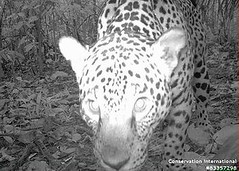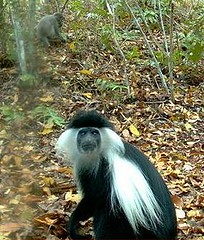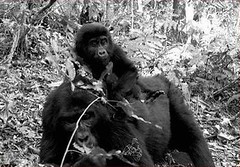 一個監控生態系統和物種多樣性的跨國保育團隊,已經在三個洲的熱帶森林,利用遠距「相機陷阱」(camera trap)捕捉到100萬多張照片。
一個監控生態系統和物種多樣性的跨國保育團隊,已經在三個洲的熱帶森林,利用遠距「相機陷阱」(camera trap)捕捉到100萬多張照片。
第100萬張照片的主角是神祕的美洲豹,於2012年6月在秘魯馬奴國家公園拍攝。目前這個計畫已經取得112萬1895張照片,而且數字還在增加當中。
生態學家阿馬達(Jorge Ahumada)是「熱帶生態學評估與監測行動」(Tropical Ecology Assessment and Monitoring,TEAM)網絡的技術指導,他說:「第100萬張照片正是我們相機陷阱驚奇的代表作,象徵這個蒐集新數據計畫的成功。」
TEAM網絡由國際保育協會以及美國的密蘇里植物園、史密森尼學會和野生動物保育協會組成,同時透過80個當地的合作機構執行計畫。
阿馬達是國際保育協會在美國阿林頓的工作人員,他表示:「我們慶祝這個成就的同時,也來到關鍵時刻,開始要提供當地以至於全世界的政策決策者,有關氣候變遷和棲息地流失是如何影響生物多樣性的資訊。」
野生動物保育協會(TEAM的合作機構之一)的資深副會長金斯堡(Joshua Ginsberg)表示:「保育工作通常和創紀錄無關,除非像這次達到以百萬計算的成就。」
金斯堡說:「這100萬張照片讓我們可以發展和測試全球指標,對於測量全球保育活動和提供全球社群有關全世界生物多樣性的狀態越來越危急,非常關鍵。」
這些照片提供即時資訊,讓我們了解一些難以窺見的動物族群如何受到氣候、棲息地和土地利用變遷的影響,而這些改變也會影響熱帶森林的健康,以及其中貨物的運送和提供給人們的服務。
TEAM網絡的研究區域涵蓋14個國家,共16個保護區。相機陷阱設置於拉丁美洲的巴西、哥斯大黎加、厄瓜多、巴拿馬、祕魯和蘇利南,以及亞洲的印尼、寮國和馬來西亞,非洲的喀麥隆、剛果的布拉柴維爾、馬達加斯加、坦尚尼亞和烏干達。
 TEAM網絡已經利用標準化方法監控熱帶森林的變化長達10年,期間蒐集了樹木、哺乳動物、氣候、藤蔓植物和鳥類的數據。
TEAM網絡已經利用標準化方法監控熱帶森林的變化長達10年,期間蒐集了樹木、哺乳動物、氣候、藤蔓植物和鳥類的數據。
在訪談中阿馬達告訴ENS,身為這個計畫的技術指導,他過去七年的工作就是確保各地參與人員持續使用同樣的方法,包括在旱季架設陷阱、使用同樣的拍攝技術和設備,所以在這些不同區域的研究活動,得以組成一個「橫跨全世界的大型實驗」。
TEAM和當地機構合作,由當地的管理者與技術人員架設相機陷阱。相機放在架子裡,擺放在森林裡30天,每個地點一年能蒐集1~3萬張照片。
阿馬達表示當地居民(包括學生)協助擺放由電池供電的相機,並負責取回。他解釋道:「這當中的工作相當繁重。每兩平方公里只擺放一台相機,而整個區域有120平方公里大,所以該區域會有60個相機陷阱。」
阿馬達表示這些協助人員都有支薪,他說:「在兩個相機陷阱之間,他們必須步行很長一段路。只為了架設相機,他們可能得在沒有步道的森林行走15天,當然也睡在森林裡。」
有些相機陷阱的設置地點發生紛爭,阿馬達表示:「我們試著不要在發生內戰的區域工作,我們通常在安全以及有法律保障的地區工作。」
他說:「我們必須取得環境或國家公園部的官方核准,所以我們選擇和已經被核准在這些公園進行工作的機構合作。而有一些區域我們的合作機構也進行了安排,因此工作人員知道自己是安全的。」
 偷獵者和欲拍攝的動物,是TEAM網絡工作人員的主要威脅。阿馬達說:「因為由遠紅外線感應,所以很難發現這些相機陷阱,有時我們會拍到偷獵者。」
偷獵者和欲拍攝的動物,是TEAM網絡工作人員的主要威脅。阿馬達說:「因為由遠紅外線感應,所以很難發現這些相機陷阱,有時我們會拍到偷獵者。」
他表示:「在烏干達無法穿越的布溫迪森林(計畫裡的一個保護區),我們發現偷獵者出現在照片中。計畫裡有認識偷獵者的人,他們會私下處理,因此很難告發偷獵者。」
一旦工作人員從森林裡的陷阱取回記憶卡,便在電腦瀏覽這些照片,利用專門為這個研究發展的軟體進行辨識。
這16個地點的合作機構會將照片壓縮,傳送給阿馬達的團隊。他解釋道:「我們將照片放進資料庫並累積計算。我們其實不需要看過所有照片,就能得知重要訊息。同一動物在同一地點出現越多次,就會被拍到越多照片,這就告訴我們族群的資訊。」
「我們在一開始的基線研究裡,已經確立放置相機陷阱的保護區大小和被拍到的物種數目有強烈關聯。我們預期會有這樣的結果,也發現這是普遍的情形。」
不過還是有意料之外的發現。阿馬達發現雜食(以多種類型食物維生)的哺乳動物,比起草食和肉食動物,對於保護區裡環境改變更敏感。他說:「這有點令人驚訝。」
如今阿馬達團隊有了這100萬張照片,正準備開始進行更深入的分析。這100萬張照片是從16個地點共960個相機陷阱蒐集到的,這些地方名列如下:
- 巴拿馬:莎柏蘭尼亞國家公園(Soberania National Park)的巴羅科羅拉多自然遺產保護區(Barro Colorado Nature Monument)
- 印尼:布吉巴里桑西拉坦國家公園(Bukit Barisan Selatan National Park)
- 烏干達:無法穿越的布溫迪森林(Bwindi Impenetrable Forest)
- 巴西:Caxiuanã國家森林(Caxiuanã National Forest)
- 蘇利南:蘇利南中部自然保護區(Central Suriname Nature Reserve)
- 祕魯:馬奴國家公園(Manu National Park)
- 喀麥隆:可魯普國家公園(Korup National Park)
- 巴西:瑪瑙斯(Manaus)
- 寮國:Nam Kading國家保護區(Nam Kading National Protected Area)
- 剛果共和國:Nouabalé Ndoki國家公園(Nouabalé Ndoki)
- 馬來西亞:帕索森林保護區(Pasoh Forest Reserve)
- 馬達加斯加:拉努馬法納國家公園(Ranomafana National Park)
- 坦尚尼亞:烏德宗瓦山脈國家公園(Udzungwa Mountains National Park)
- 哥斯大黎加:巴爾瓦火山(Volcan Barva Transect)
- 祕魯:亞納查加-切米連國家公園(Yanachaga-Chemillén National Park)
- 厄瓜多:葉蘇尼國家公園(Yasuni National Park)和生物圈保護區(Biosphere Reserve)
點擊觀看相機捕捉的研究影片: bit.ly/VeqclT
Remote camera traps have captured more than one million photographs of animals and birds in tropical forests on three continents for a global team of conservationists monitoring changes in ecosystems and species diversity.
The millionth photograph, of an elusive jaguar, was captured in Peru's Manu National Park in June 2012. The project has now snapped 1,121,895 images and is still counting.
"The one-millionth image is an amazing representation of our camera trap work, and it symbolizes the success we have had with this program in collecting new data," says ecologist Dr. Jorge Ahumada, technical director with the Tropical Ecology Assessment and Monitoring, TEAM, Network.
The TEAM Network is a partnership among Conservation International, Missouri Botanical Garden, Smithsonian Institution and the Wildlife Conservation Society and is implemented through over 80 local partner institutions.
"As we celebrate this accomplishment, we are also at a critical point in beginning to provide information to decision makers from the local to global level on how biodiversity is affected by climate change and habitat loss," said Ahumada, who works at Conservation International based in Arlington.
"Conservation is not usually about setting records, but there are times when the scale of an achievement can be measured in the millions," said Dr. Joshua Ginsberg, senior vice president, Wildlife Conservation Society, one of TEAM's partner institutions.
"One million pictures allow us to develop and test global indicators that are critical to measuring the success of global conservation and informing the global community on the increasingly perilous state of the world's biodiversity," Ginsberg said.
The images provide real-time information on how animal populations that are usually unseen are affected by changes in climate, habitat and land use that in turn affect the health of tropical forests and flow of goods and services to people.
The TEAM Network's study area covers 16 protected areas in 14 countries.
In Latin America, camera traps are operating in Brazil, Costa Rica, Ecuador, Panama, Peru and Suriname. In Asia, the cameras are capturing images in Indonesia, Laos and Malaysia. In Africa, cameras are set up in Cameroon, Congo Brazzaville, Madagascar, Tanzania and Uganda.
The TEAM Network has monitored changes in tropical forests for 10 years, using standardized methods to collect data on trees, mammals, the climate, woody vines known as lianas, and birds.
Ahumada told ENS in an interview that as the project's technical director for the past seven years his job is to ensure that people consistently use the same methods across all sites – set the traps always in the dry season, use the same camera technology and the same equipment – so that all these activities in many different areas constitute a "huge experiment across the world."
Working through local partner institutions, TEAM site managers and technicians set the traps. Cameras are placed in a grid throughout the forest and left for 30 days. Each site collects between 10,000 and 30,000 photographs a year.
Ahumada says local people, including students, place the cameras, which operate on batteries, and go back to retrieve them. "The amount of work involved is huge," he explained. "These cameras are spaced out every two square kilometers, or 1.5 square miles, over an area of 120 square kilometers. There should be 60 camera traps in that area."
All the workers are paid, Ahumada said. "They have to walk a lot between camera traps. Just to install them can take 15 days of walking through the forest with no trails; they sleep in the forest."
Some camera traps are placed in areas of conflict. Ahumada said, "We try not to work in areas of civil war. In general, we work in places that are secure and protected by law."
"We have to get official permission from ministries of environment or parks," he said. "We choose partners who already have permits to work in those parks. In some areas our partners have arrangements so they know they're going to be safe."
Poachers are the main threat to TEAM Network personnel as well as to the animals they are trying to capture on camera. "The camera traps are difficult to see; they are camouflaged with infra-red flash. Sometimes we get pictures of poachers," Ahumada said.
In one of the study's protected area, the Bwindi Impenetrable Forest in Uganda, he said, "We've had poachers show up at the camera traps. People from the project know who they are and have arrangements with them. It's difficult to turn them in."
Once the memory cards are retrieved from the forest traps, workers go through the images on computers and identify them with software developed specifically for this study.
From all the 16 sites, the local partners send Ahumada's group the images in compressed format. "We put them in our database, where can count them," he explained. "We don't see all the images, but we don't need to see the images to extract the important information. The more abundant an animal is in a place, the more images we get. This tells us about the populations."
"In our first baseline study, we really found a very strong relationship between size of protected areas where the camera traps are placed and the number of species that you get on camera. We were expecting this result, and we found that this is a pervasive pattern."
But there have been surprises. Ahumada has observed that mammals that feed on many types of foods, called omnivores, are more sensitive to changes in the protected reserve sites than herbivores or carnivores. "That was a little surprising," he said.
Now with a million images, Ahumada and his team are starting to do more in depth analysis.
The million images have been collected from 960 camera trap points across the 16 sites. They are:
Barro Colorado Nature Monument – Soberania National Park (Panama)
Bukit Barisan Selatan National Park (Indonesia)
Bwindi Impenetrable Forest (Uganda)
Caxiuanã National Forest (Brazil)
Central Suriname Nature Reserve (Suriname)
Manu National Park (Peru)
Korup National Park (Cameroon)
Manaus (Brazil)
Nam Kading National Protected Area (Lao PDR)
Nouabalé Ndoki (Republic of Congo)
Pasoh Forest Reserve (Malaysia)
Ranomafana National Park (Madagascar)
Udzungwa Mountains National Park (Tanzania)
Volcan Barva Transect (Costa Rica)
Yanachaga-Chemillén National Park (Peru)
Yasuni National Park and Biosphere Reserve (Ecuador)
Click here to watch a video about the camera trap research.
※ 全文及圖片詳見:ENS




